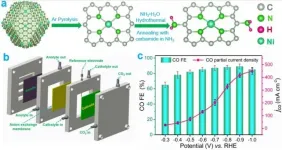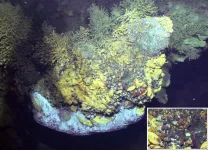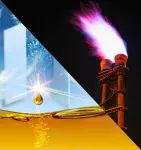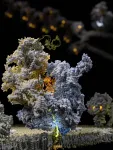(Press-News.org) Researchers at Tampere University have successfully used artificial intelligence to predict nonlinear dynamics that take place when ultrashort light pulses interact with matter. This novel solution can be used for efficient and fast numerical modelling, for example, in imaging, manufacturing and surgery. The findings were published in the prestigious Nature Machine Intelligence journal.
Artificial intelligence can distinguish different types of laser pulse propagation, just as it recognizes subtle differences of expression in facial recognition. The newly found solution can make it simpler to design experiments in fundamental research and will allow algorithms to be embedded in the next generation of laser systems to ensure real-time optimization. This can be utilised for example in manufacturing and surgery where the pulse properties are perturbed by a target environment.
Nonlinear ultrafast light-matter interactions are something that researchers have struggled to understand for decades. The field of study is of vital importance in many areas of research, ranging from the use of spectroscopic tools in drug development to the precision machining of technological materials and remote sensing to high-resolution imaging.
Neural networks can be trained to recognize patterns
When a high-power ultrashort pulse of light interacts with a glass optical fibre, a range of highly nonlinear interactions take place that cause complex changes in both the temporal and spectral (color) properties of the injected light. Up to now, the study of these nonlinear and multidimensional interactions has been based on nonlinear Schro?dinger equation, a slow and computationally demanding method that has limited dramatically the use of numerical techniques to design or optimize experiments in real-time.
"This problem has now been solved by using artificial intelligence. Our team has been able to train a neural network to recognize the patterns inherent in such complex evolution. Significantly, once trained, the network is also able to predict nonlinear evolution for a previously unknown scenario, and can do so essentially instantaneously," says professor Goëry Genty, the leader of the research group at Tampere University and the Director of the national Flagship for Photonics Research and Innovation.
This research uses a specialized architecture known as the 'recurrent neural network' that possesses an internal memory. Such a network can not only recognize specific patterns associated with nonlinear dynamics, but it can also learn how such patterns evolve in both the temporal and spectral domains over an extended distance.
The neural network can predict an evolution in milliseconds. The novel solution will lead to more efficient and faster numerical modelling of all systems where nonlinearity influences propagation, improving the design of devices used in telecommunications, manufacturing, and imaging.
New applications available in photonics
The study reports two cases of highly significant interest in photonics: extreme pulse compression and ultrabroadband laser source development.
"The approach using a neural network with internal memory allows us to bypass the conventional approach of solving an underlying mathematical model, which is very time consuming and requires sometimes prohibitive memory resources" explains Genty.
With the rapid growth of machine learning applications in all fields of science, Genty anticipates that neural networks will very soon become an important and standard tool for analyzing complex nonlinear dynamics, for optimizing the generation of broadband sources and frequency combs, as well as for designing ultrafast optics experiments.
INFORMATION:
The research was carried out at Tampere University as part of the Applications of Artificial Intelligence in Physical Sciences and Engineering Program (AIPSE) and within the Academy of Finland's Flagship for Photonics Research and Innovation (PREIN).
Read more on Predicting ultrafast nonlinear dynamics in fibre optics with a recurrent neural network in Nature Machine Intelligence. The article was written by Lauri Salmela, Nikolaos Tsipinakis, Alessandro Foi, Cyril Billet, John M. Dudley, and Goëry Genty.
Carbon dioxide (CO2) electrocatalytic reduction driven by renewable electricity can solve the problem of excessive CO2 emissions. Since CO2 is thermodynamically stable, efficient catalysts are needed to reduce the energy consumption in the process.
The single-atom catalysts immobilized on nitrogen-doped carbon supports (M-N/C) have been widely used for CO2 electrocatalytic reduction reaction due to their high atom utilization efficiency.
Recently, a research team led by Prof. LIU Licheng from the Qingdao Institute of Bioenergy and Bioprocess Technology (QIBEBT) of the Chinese Academy of Sciences (CAS) proposed a two-step amination strategy to regulate the electronic structure of M-N/C catalysts (M=Ni, Fe, Zn) and enhance the intrinsic activity of CO2 electrocatalytic reduction.
In ...
EUGENE, Ore. -- Feb. 19, 2021 -- Friction caused by dry Martian dust particles making contact with each other may produce electrical discharge at the surface and in the planet's atmosphere, according University of Oregon researchers.
However, such sparks are likely to be small and pose little danger to future robotic or human missions to the red planet, they report in a paper published online and scheduled to appear in the March 15 print issue of the journal Icarus.
Viking landers in the 1970s and orbiters since then detected silts, clays, wind-blown bedforms and dust devils on Mars, raising questions about potential electrical activity.
Scientists ...
China is just one of many countries in the Northern Hemisphere having what researchers are calling an "extremely cold winter," due in part to both the tropical Pacific and the Arctic, according to an analysis of temperatures from Dec. 1, 2020, to mid-January of 2021. A country-specific case study, the investigation potentially has far-reaching implications for predictions and early warnings to protect against harmful impacts, researchers said.
The results were published online, ahead of print, on Feb. 12 in Advances in Atmospheric Sciences.
"We are trying to explain why the countries in the Northern Hemisphere ...
Nanoparticles used in drug delivery systems, bioimaging, and regenerative medicine migrate from tissues to lymphatic vessels after entering the body, so it is necessary to clarify the interaction between nanoparticles and lymphatic vessels. Although technology to observe the flow of nanoparticles through lymphatic vessels in vivo has been developed, there has been no method to evaluate the flow of nanoparticles in a more detailed and quantitative manner ex vivo. Thus, research was conducted to develop an ex vivo lymphatic vessel lumen perfusion system to determine how nanoparticles move in lymphatic vessels and how they affect the physiological movement of lymphatic vessels.
Nanoparticles introduced into the ...
A research team led by Prof. QIAN Peiyuan, Head and Chair Professor from the Hong Kong University of Science and Technology (HKUST)'s Department of Ocean Science and David von Hansemann Professor of Science, has published their cutting-edge findings of symbiotic mechanisms of a deep-sea vent snail (Gigantopelta aegis) in the scientific journal Nature Communications. They discovered that Gigantopelta snail houses both sulfur-oxidizing bacteria and methane-oxidizing bacteria inside its esophageal gland cells (part of digestive system) as endosymbionts. By decoding the ...
A new study looking at how COVID-19 affects people with asthma provides reassurance that having the condition doesn't increase the risk of severe illness or death from the virus.
George Institute for Global Health researchers in Australia analysed data from 57 studies with an overall sample size of 587,280. Almost 350,000 people in the pool had been infected with COVID-19 from Asia, Europe, and North and South America and found they had similar proportions of asthma to the general population.
The results, published in the peer-reviewed END ...
Researchers at the University of Illinois Chicago have discovered a way to convert the methane in natural gas into liquid methanol at room temperature.
This discovery, reported in the journal Proceedings of the National Academy of Sciences, could potentially provide a cleaner energy source for many of our everyday activities.
When burned, natural gas -- the fuel used to heat homes, cook food and generate electricity -- produces carbon dioxide, a powerful greenhouse gas.
According to the U.S. Energy Information Administration, the U.S. consumed approximately 31 trillion cubic feet of natural gas in 2019, contributing roughly 1.6 gigatons of carbon dioxide to the atmosphere.
A better way to use natural gas would be to convert it to methanol, a liquid fuel that burns more ...
University of Queensland scientists have developed an ultraviolet 'television' display designed to help researchers better understand how animals see the world.
Until now, standard monitors on devices like televisions or computer screens have been used to display visual stimuli in animal vision studies, but none have been able to test ultraviolet vision - the ability to see wavelengths of light shorter than 400 nanometres.
Dr Samuel Powell, from the Queensland Brain Institute's Marshall lab, said this new technology will help unveil the secrets of sight in all sorts of animals, such as fish, birds and insects.
"Human TVs generally use three colours - red, green and blue - to create images, but our newly-developed ...
Mitochondria are organelles that act as the powerhouses in our body. They use oxygen which we inhale and food we eat to produce energy that supports our life. This molecular activity is performed by bioenergetic nano-factories incorporated in specialized mitochondrial membranes. The nano-factories consist of proteins cooperatively transporting ions and electrons to generate chemical energy. Those have to be constantly maintained, replaced and duplicated during cell division. To address this, mitochondria have their own bioenergy protein-making machine called the mitoribosome. Given its key role, a deregulation of the mitoribosome can lead to medical disorders such as deafness and diseases including cancer development. The first fundamental understanding of how mitoribosomes ...
A POSTECH-KAIST joint research team has successfully developed a technique to reach near-unity efficiency of SHEL by using an artificially-designed metasurface.
Professor Junsuk Rho of POSTECH's departments of mechanical engineering and chemical engineering, and Ph.D. candidate Minkyung Kim and Dr. Dasol Lee of Department of Mechanical Engineering in collaboration with Professor Bumki Min and Hyukjoon Cho of the Department of Mechanical Engineering at KAIST have together proposed a technique to enhance the SHEL with near 100% efficiency using an anisotropic metasurface. For this, the joint research team designed a metasurface that transmits most ...




